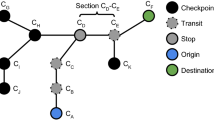Abstract
One of the objectives of railway infrastructure managers is to improve the punctuality of their operations while satisfying safety requirements and coping with limited capacity. To fulfil this objective, capacity planning and monitoring have become an absolute necessity. Railway infrastructure managers possess tremendous amounts of data about the railway operations, which are recorded in so-called train describer systems. In this paper, a set of methods is proposed to guide the analysis of capacity usage based on these data. In particular, train connections are categorized according to the severity of train reroutings as well as the diversity of these reroutings. The applied method is able to highlight areas in the railway network, where trains have a higher tendency to diverge from their allocated route. The method is independent from the underlying infrastructure, and can, therefore, be reused effortlessly on new cases. The analysis provides a starting point to improve the planning of capacity usage and can be used to facilitate the communication between capacity planning at one hand and operations on the other hand. At the same time, it presents an illustration on how process mining can be used for analysis of train describer data.











Similar content being viewed by others
Notes
A graph is strongly connected if there is a path from each node to any other node.
Both train numbers and signals have been anonymised.
References
Agrawal R, Gunopulos D, Leymann F (1998) Mining process models from workflow logs. In: Schek HJ, Saltor F, Ramos I, Alonso G (eds) Advances in database technology—EDBT ’98, vol 1377. Springer, Berlin, pp 467–483
Carey M, Kwieciski A (1994) Stochastic approximation to the effects of headways on knock-on delays of trains. Transp Res Part B Methodol 28(4):251–267
Conte C, Schöbel A (2008) Identifying dependencies among delays. PhD thesis, Niedersächsische Staats-und Universitätsbibliothek Göttingen, Germany
Cook JE, Wolf AL (1999) Software process validation: quantitatively measuring the correspondence of a process to a model. ACM Trans Softw Eng Methodol (TOSEM) 8(2):147–176
Cule B, Goethals B, Tassenoy S, Verboven S (2011) Mining train delays. Advances in intelligent data analysis X. Springer, Berlin, pp 113–124
Daamen W, Goverde RMP, Hansen IA (2008) Non-discriminatory automatic registration of knock-on train delays. Netw Spatial Econ 9(1):47–61
D’Ariano A (2008) Improving real-time train dispatching: models, algorithms and applications. T2008/6, Netherlands TRAIL Research School
De Weerdt J, De Backer M, Vanthienen J, Baesens B (2012) A multi-dimensional quality assessment of state-of-the-art process discovery algorithms using real-life event logs. Inf Syst 37(7):654–676
Demšar J (2006) Statistical comparisons of classifiers over multiple data sets. J Mach Learn Res 7:1–30
Dewilde T (2014) Improving the robustness of a railway system in large and complex station areas. PhD thesis, KULeuven, Belgium
Flier H, Gelashvili R, Graffagnino T, Nunkesser M (2009) Mining railway delay dependencies in large-scale real-world delay data. Robust and online large-scale optimization. Springer, Berlin, pp 354–368
Goverde RMP, Meng L (2011) Advanced monitoring and management information of railway operations. J Rail Transp Plann Manag 1(2):69–79
Hay B, Wets G, Vanhoof K (2004) Mining navigation patterns using a sequence alignment method. Knowl Inf Syst 6(2):150–163
Higgins A, Kozan E (1998) Modeling train delays in urban networks. Transp Sci 32(4):346–357
Iversen GR, Norpoth H (1987) Analysis of variance. 1. Sage, New York
Kecman P, Goverde RMP (2015a) Online data-driven adaptive prediction of train event times. IEEE Trans Intell Transp Syst 16(1):465–474
Kecman P, Goverde RMP (2015b) Predictive modelling of running and dwell times in railway traffic. Public Transp 7(3):295–319
Kruskal WH, Wallis WA (1952) Use of ranks in one-criterion variance analysis. J Am Stat Assoc 47(260):583–621
McCabe TJ (1976) A complexity measure. IEEE Trans Softw Eng 2(4):308–320
Mendling J, Neumann G, Van Der Aalst W (2007) Understanding the occurrence of errors in process models based on metrics. In: On the move to meaningful internet systems 2007: CoopIS, DOA, ODBASE, GADA, and IS. Springer, Berlin, pp 113–130
Nemenyi PB (1963) Distribution-free multiple comparisons. PhD thesis, Princeton University
Rozinat A, De Medeiros AKA, Günther CW, Weijters AJMM, van der Aalst WMP (2007) Towards an evaluation framework for process mining algorithms. Beta, Research School for Operations Management and Logistics, USA
Sammouri W (2014) Data mining of temporal sequences for the prediction of infrequent failure events: application on floating train data for predictive maintenance. PhD thesis, Université Paris-Est
Törnquist J (2006) Computer-based decision support for railway traffic scheduling and dispatching: a review of models and algorithms. In: 5th workshop on algorithmic methods and models for optimization of railways, p 659
vanden Broucke SKLM, De Weerdt J, Vanthienen J, Baesens B (2013) A comprehensive benchmarking framework (CoBeFra) for conformance analysis between procedural process models and event logs in ProM. In: 2013 IEEE symposium on computational intelligence and data mining (CIDM). IEEE, New York, pp 254–261
van der Aalst WMP (2011) Process mining: discovery, conformance and enhancement of business processes. Springer, Heidelberg
van der Aalst WMP, Adriansyah A, van Dongen B (2012) Replaying history on process models for conformance checking and performance analysis. Wiley interdisciplinary reviews: data mining and knowledge discovery 2(2):182–192
Watson AH, McCabe TJ, Wallace DR (1996) Structured testing: a testing methodology using the cyclomatic complexity metric. NIST Spec Publ 500(235):1–114
Weeda VA, Hofstra KS, Allen J et al (2008) Performance analysis: improving the dutch railway service. In: Proceedings computers in railways XI, pp 463–471
Yuan J, Hansen IA (2007) Optimizing capacity utilization of stations by estimating knock-on train delays. Transp Res Part B Methodol 41(2):202–217
Author information
Authors and Affiliations
Corresponding author
Rights and permissions
About this article
Cite this article
Janssenswillen, G., Depaire, B. & Verboven, S. Detecting train reroutings with process mining. EURO J Transp Logist 7, 1–24 (2018). https://doi.org/10.1007/s13676-017-0105-8
Received:
Accepted:
Published:
Issue Date:
DOI: https://doi.org/10.1007/s13676-017-0105-8




